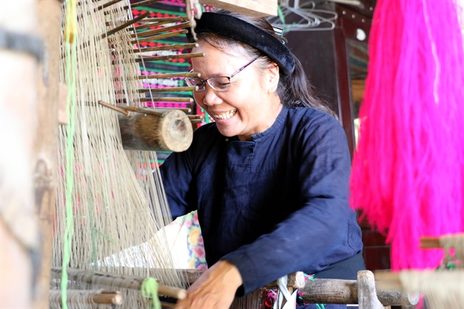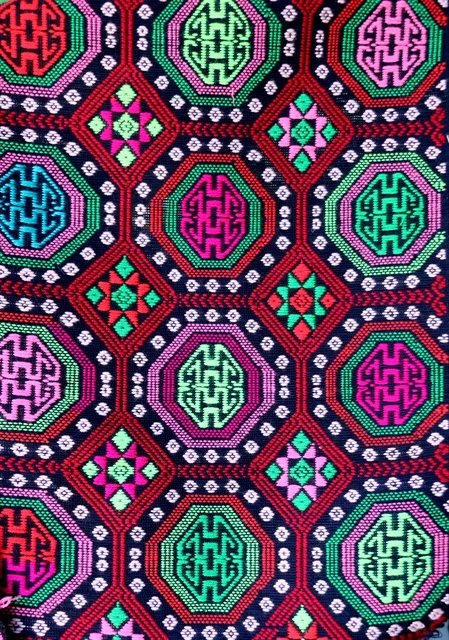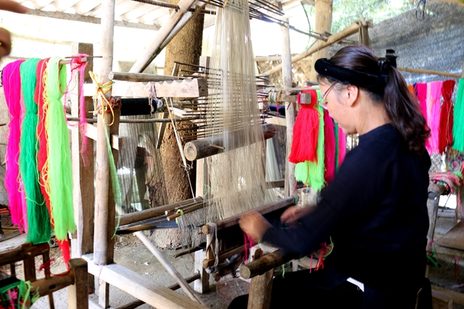(News) - The image of Tày women sitting beside looms to weave brocade used to be a familiar sight in the northern mountainous province of Cao Bằng.
The group was well-known for the colourful patterns which were passed down from generation to generation.
But now, Luống Nọi is the only village in Hà Quảng District that preserves its ancient weaving techniques and tools, and the only area that still retains this traditional brocade weaving of the Tày people. The village is part of a cultural heritage site in the Non Nước Cao Bằng UNESCO Global Geopark. This area allows tourists to learn about the culture, history, faith and traditional practices of local people.
Deep passion for the craft

Nông Thị Thược was the Tày weaver awarded the title "Golden Award for a Traditional Craft Family" by the Việt Nam Craft Association.
We visited the house of Tày artisan Nông Thị Thược in Luống Nọi Village on a morning when bright sunlight was dancing everywhere. Thược is the fourth generation of her family to carry forward traditional brocade weaving, and she was the first among the Tày people to be awarded the title "Golden Award for a Traditional Craft Family" by the Việt Nam Craft Association in 2016.
Her house is simple with walls made from red clay. The sound of wooden looms clattered and then melodies (Tày singing) came from Thược's mobile phone. Her house was full of brocade products with colourful, eye-catching and traditional patterns.
"Our traditional brocade weaving skills include spinning yarn, framing, creating patterns and weaving fabric," Thược said. "All these stages require patience, meticulousness and creativity."
Stunning patterns

STANDING OUT: Handmade patterns designed by Tày ethnic people in Luống Nọi Village.
"Each pattern is a combination of bright, dark, warm and cool colours placed harmoniously against an opalescent background. This makes the brocade created by Tày people in Cao Bằng Province different from Tày people in other locations, and distinct from other ethnic minority groups," Thược said.
According to Hoàng Thi Nhuận, a researcher on Cao Bằng culture, Luống Nọi villagers began weaving brocade about 500 years ago. Their products quickly became famous nationwide. In the old days, they grew the cotton themselves.
"The main materials for brocade weaving are indigo-dyed cotton yarn and dyed silk," Nhuận said.
"There are six colours used by the Tày people: blue, red, yellow, purple, white and black. The patterns vary, resulting in special products," Nhuận added.
The colour scheme is very important in brocade. There are embossed patterns in vivid colours which stand out against submerged patterns representing the Earth. The colourful embossed patterns symbolise all things found on Earth. That's the way the Tày people perceive the universe.
There are 20 different patterns used in their brocade including images of plum, peach and apricot blossoms, rare wild flowers, animals and birds, which are mixed with clouds in the sky, mountains and rivers.
"As a deep-rooted tradition, Tày girls have to learn brocade weaving to make their own wedding dresses," Thược said.
"We start learning when we are very young, so weaving clothes, blankets, mosquito nets, pillows and mattresses is a normal thing that everyone can do.
"The patterns have evolved, and while we're working in the fields, we think about creating new flowery patterns - how the threads should be arranged and how many threads and colours should be used," Thược said.

AT WORK: Artisan Thược designs brocade patterns. She said weavers need to think about the number of threads and colours needed to produce their desired patterns. Some patterns need 20 bamboo sticks to create a frame. Others might need as many as 100.
The Tày women weave brocade to make blankets, slings, sheets and traditional costumes. They construct the looms themselves, and the designs are stored in their heads, not on paper.
"Each weaver has to think of the number of threads and colours needed to produce the desired patterns. Some patterns need 20 bamboo sticks to create a frame. Others might need as many as 100," Thược said.
According to researcher Nhuận, traditionally, the flower patterns had eight petals. Now the design has changed to meet different modern demands. But no matter how much the products have evolved, they still reflect the Tày people's culture. Their embroidered brocade products have stunning patterns with various meanings, reflecting the cultural lives and beliefs of the people.
Preservation desire
The traditional brocade weaving craft in Luống Nọi Village has been around for centuries. Many artisans in the village like Nông Thị Thược, Nông Thị Duyên, Hoàng Thị Lệ, Nông Thị Iu and Đàm Thị Sùi have devoted their lives to creating more and more unique products, contributing to preserving their cultural values.
According to artisan Nông Thị Duyên, there are only a few brocade households left in the village. They do it to satisfy their passion, as well as to hand the craft down for their next generations, and to create jobs in their spare time.
"Although our products are special, we are unable to mass produce because they are all handmade," Duyên said.
"Another thing is that there are only a few artisans left, and most of them are old. Not many youngsters want to get involved in the craft. That makes it difficult to train our children and hand the craft down," Duyên added.
According to head of Luống Nọi Village Hoàng Văn Tín each brocade household earns about VNĐ30 million (US$1,300) per year. He hopes provincial authorities will come up with measures to preserve and develop their traditional craft and cultural values.
Source: VNS (by Bui Quynh Hoa)
VNQD